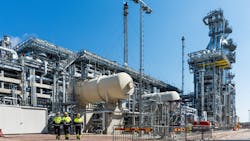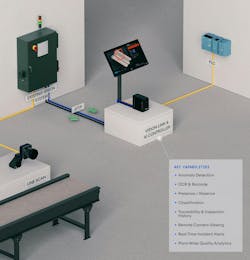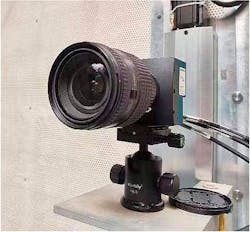What Are They Using? Equipment Choices Preem, International Paper, New Flyer, and More
Have you ever been curious what your main competitor or even just other companies similar to you are using in their facilities? Maybe you saw a machine or piece of equipment and wanted to know where it was from and if they like it.
In this recurring news round-up, we'll be compiling all the news about who bought what, who delivered what to who, and so on so you can see how other companies are operating and the tools they're using.
Hexagon Purus to Supply Hydrogen Cylinders for Transit Buses in N.A.
Hexagon Purus, a manufacturer of zero-emission mobility and infrastructure solutions, has been selected by New Flyer, North America's largest mass mobility solutions provider, to supply hydrogen cylinders for the fifth consecutive year.
New Flyer, a subsidiary of NFI Group Inc., is on a mission to enable zero-emission transportation in North America, deploying hydrogen buses and infrastructure in cities across the U.S. and Canada.
Hexagon Purus will continue to provide its Type 4 hydrogen storage cylinders for North America’s most advanced hydrogen bus, the Xcelsior CHARGE FC.
New Flyer's next-generation, zero-emission hydrogen fuel cell-electric transit bus enables a driving range of 370+ miles (600 km) on a single refueling. The total value of this contract is estimated to be approximately USD 6.3 million.
Hexagon Purus’ Westminster, Maryland facility will produce the storage cylinders and will deliver them throughout 2025 to New Flyer.. Since 2020, Hexagon Purus has delivered hydrogen cylinders for more than 200 New Flyer hydrogen fuel cell-electric transit buses.
Preem to Use Alleima Heat Exchanger Tubes to Advance Sustainability in Aviation
Preem is set to transition its Lysekil refinery from fossil to renewable fuels, and it has decided to use Alleima's heat exchanger tubes made from its Sanicro 35 alloy which combines the best features of a super austenitic stainless steel and a nickel alloy.
Sweden is on a green energy transition across the country and this investment will make Preem the largest producer of renewable jet fuel in northern Europe.
Preem started redeveloping its IsoCracker plant (ICR) in Lysekil in late 2024. Once completed, it will produce 1.2 million cubic meters of renewable fuels per year as well as reduce fossil carbon dioxide emissions at user level by 2 to 3 million tons per year. At the same time, Preem will reduce fossil fuel production by a corresponding amount.
"Reducing greenhouse gas emissions is one of the great challenges of our time. I am therefore proud that Preem is now making the biggest change in the company's history. We are doing this by converting the diesel plant at the refinery in Lysekil. When the conversion is complete, we will be Scandinavia's largest producer of renewable jet fuel," says Tommy Johansson, project manager for the ICR project at Preem.
The changeover means that Preem will no longer use fossil raw materials such as crude oil, but renewable raw materials instead. To make this possible, advanced technology is required, not least in the pre-treatment unit (PTU) that will be built. The raw materials will be pre-treated and purified at high temperatures before being used to produce renewable fuels such as Hydrotreated Vegetable Oil (HVO), diesel made from vegetable oils or plant products and Sustainable Aviation Fuel (SAF).
The processes in refineries often place high demands on the materials used and renewable fuels are particularly challenging. The raw materials used usually contain chlorides, which can cause corrosion. Therefore, special materials are required that can withstand high temperatures and aggressive chemical environments without corroding.
"We are very happy that Alleima has been trusted to supply heat exchanger tubes and pipes to Preem. Alleima has a long history as a supplier of special steel to Preem's refineries. The special alloy Sanicro 35, is an austenitic stainless-steel alloy intended for extremely corrosive environments and an alternative to the use of nickel bases in the heat exchangers for preheating and cooling the renewable raw materials in the PTU. Before a decision could be made, we conducted extensive lab tests together with Preem, which showed that Sanicro 35 can withstand the extreme conditions and process environments of the pretreatment plant. This resulted in a strong alternative to the more expensive nickel-based alloys that are otherwise used,” says Barinder Ghai, Director of Technical Marketing, New Business Development for the Tube division at Alleima.
International Paper Uses Elementary's AI Vision Platform to Modernize Line Scan System
Elementary recently implemented its new Vision Link platform at International Paper, a pulp & paper manufacturer, demonstrating Vision Link's transformative potential. The company's existing line scan system was reliable but limited, requiring extensive manual intervention to validate and classify defects. Quality teams were spending countless hours reviewing potential defects, and high false-positive rates were leading to unnecessary waste.
Rather than undertaking a complete system overhaul, the facility took an approach that preserved its existing infrastructure while adding AI capabilities.
With Vision Link, International Paper was able to eliminate over 375,000 manual classifications annually, significantly reducing false positives and material waste, and also achieved 100% defect traceability. The implementation was completed in one week with no disruption to its production. Vision Link integrated easily with existing cameras and infrastructure, minimizing costs.
The solution's cloud-based traceability allowed the team to track defects in real time and quickly identify root causes. They shifted from a reactive quality control approach to proactively addressing issues before they impacted production.
Aeronautics Researchers Use Mikrotron Camera for New Projectile Flight Measurements
Researchers at the School of Aeronautics, Northwestern Polytechnical University, and the Xi'an Institute of Modern Control Technology have devised a new optical measurement system that's simple yet versatile enough to accurately measure both scanning angle and spin rate during steady-flying. While previous methods used multiple cameras, the novel system employs only a single camera, an EoSens 3CXP three-megapixel camera from Mikrotron.
The research team tested their solution in a university laboratory with a vertical wind tunnel. Wind speed in the tunnel ranged from 16 to 160 ft/s (5 to 50 m/s) to reproduce projectile flight. Each projectile was suspended in the air using a flexible rope that passed over a pulley and rotated around a plumb axis. Depending on the projectile type, spin rates were maintained between 4 to 30 revolutions/s.
Using the CoaXPress interface, the researchers set the Mikrotron camera in a fixed position at a resolution of 1280 x 1024 pixels, a focal length of 35 mm, and a frame rate of 1,000 frames/s. To ensure adequate illumination, an LED light source was also employed.
When a rotating projectile reached a steady state, the Mikrotron camera recorded a total of 5,000 images over 5 seconds. Rotation rates were determined by tracking the shapes and coordinates of projectile features using tracking algorithms or deep learning algorithms. In addition, a mathematical model for calculating the scanning angle of a steady-state projectile was derived which made it possible to measure the scanning angle from images recorded by only the camera from a fixed position.
About the Author
Laura Davis
Editor-in-Chief, New Equipment Digest
Laura Davis is the editor in chief of New Equipment Digest (NED), a brand part of the Manufacturing Group at EndeavorB2B. NED covers all products, equipment, solutions, and technology related to the broad scope of manufacturing, from mops and buckets to robots and automation. Laura has been a manufacturing product writer for eight years, knowledgeable about the ins and outs of the industry, along with what readers are looking for when wanting to learn about the latest products on the market.




